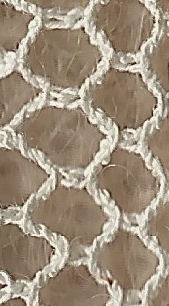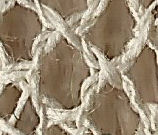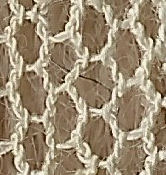
Bucks Point net is used in Bucks Point lace. It makes a honeycomb pattern. The basic stitch is half stitch and twist (usually two twists).
The technical description of Bucks Point net is CTTT, pin, or cross, twist, twist, twist, pin. It is also possible to have CTT, pin, but that is not as strong. There are no pinholes in the finished stitch, as the pin is left uncovered (there is no stitch done after the pin). In fact, it is possible to work Bucks Point net without using pins.
Click here for a description of how Bucks Point net is done, with an animation.
Click here for the whole piece of lace.



